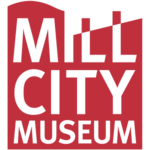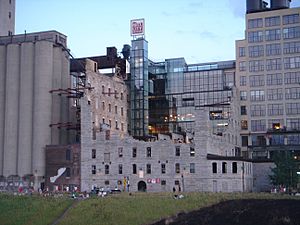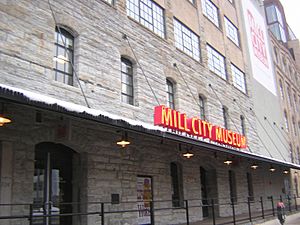Mill City Museum facts for kids
 |
|
 |
|
| Established | 2003 |
|---|---|
| Location | 704 South 2nd Street Minneapolis, Minnesota, USA |
| Type | History Museum |
| Public transit access | Bus Routes 3, 7 and 22, METRO Blue Line, METRO Green Line |
The Mill City Museum is a cool place to visit in Minneapolis, Minnesota! It's built right inside the old ruins of the Washburn "A" Mill. This museum sits next to Mill Ruins Park and right by the Mississippi River.
The museum opened in 2003 and is part of the Minnesota Historical Society. It teaches you all about how Minneapolis grew. A big part of the story is about flour milling. This industry, and others, used the powerful hydropower from Saint Anthony Falls. The old mill building itself dates back to the 1870s. It's so important that it's listed on the National Register of Historic Places. It's also part of the St. Anthony Falls Historic District.
Contents
Exploring the Museum
The Mill City Museum has lots of fun things to see and do. You can learn about the history of Minneapolis. There are also old flour milling machines to explore. You can even visit a water lab and a baking lab!
The Flour Tower Ride
The most exciting part is the "Flour Tower." You get into a special elevator that looks like a freight elevator. It takes you to different floors of the building. Each floor is set up to look like a real working flour mill. As you ride, you hear the voices of people who used to work in the Washburn A Mill. It's like they are telling you their stories!
After the ride, you get off on the 8th floor. Here, museum staff explain how the old machines worked. Then, you go up to the ninth-floor observation deck. From there, you get an amazing view of St. Anthony Falls.
Famous Flour Signs
You can still see the big Gold Medal Flour sign. It shines brightly at night from the top of the grain elevator next door. Across the river, you might spot another famous sign. It's on the old Pillsbury A Mill and says "Pillsbury's Best Flour."
Art Around the Mill
Local artists have added their creative touches throughout the museum. You can find cool murals and art made from glass. There's even a giant 15-foot (4.6 m) Bisquick box! Look for sculptures and other unique artworks.
The Washburn A Mill Story
The first Washburn A Mill was built in 1874 by Cadwallader C. Washburn. When it was finished, it was the biggest flour mill in the world! This mill helped Minneapolis grow into a major city.
The Great Mill Disaster
On May 2, 1878, something terrible happened. A tiny spark caused flour dust in the mill to explode. This huge explosion destroyed the Washburn A Mill. Fourteen workers died instantly. The fire that followed killed four more people. It also destroyed five other mills nearby. This disaster cut Minneapolis's flour-making ability by one-third.
This event is known as the Great Mill Disaster. It made national news and led to big changes in the milling industry. To stop future explosions, mills across the country added special ventilation systems. They also put in other safety devices.
A New Mill Rises
By 1880, a new Washburn A Mill was built. It was designed by an engineer from Austria named William de la Barre. This new mill also became the largest flour mill in the world. It held that title until the Pillsbury A Mill opened in 1881.
At its busiest, the Washburn A Mill could grind over 100 train cars of wheat every day. That's almost two million pounds of flour! The mill, along with others powered by St. Anthony Falls, helped Minneapolis become a flour-making giant. In 1983, the mill was named a National Historic Landmark. This was because of its new technology and its importance to the history of General Mills.
From Mill to Museum
Later, Cadwallader Washburn teamed up with John Crosby. They formed the Washburn-Crosby Company. This company eventually became General Mills, a huge food company today.
After World War I, flour production in Minneapolis started to slow down. New technology meant mills didn't need water power as much. Other cities, like Buffalo, New York, became more important for milling. General Mills also started focusing more on cereals and baking mixes. The Washburn A Mill finally closed in 1965.
In 1991, a fire almost completely destroyed the old mill. Fires and explosions were always a risk for flour mills. The A-Mill had even had another serious fire in 1928. The mill had a good sprinkler system, but it wasn't working because the building was empty and unheated.
In the late 1990s, the city of Minneapolis worked to make the mill ruins safe. They cleared away rubble and made the damaged walls strong again. Then, the Minnesota Historical Society announced plans. They wanted to build a milling museum and education center inside the ruins.
Construction on the museum began in March 2001. The architects designed a new building that used the old walls of the 1880 Washburn A Mill. They tried to keep as much of the original building as possible. Many parts of the old mill are still there. These include the pits where turbines once spun, old railroad tracks, and train sheds.
Images for kids






